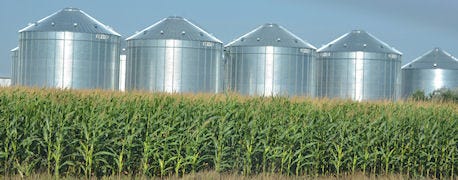May 22, 2014

If you're storing grain on the farm this spring because the elevators can't take it, make sure it doesn't start spoiling.
Ken Hellevang, North Dakota State University Extension agricultural engineer and grain drying experts, says you must keep grain cool and monitor it regularly.
The recommended moisture content to limit mold growth at summer storage temperatures normally is associated with the equilibrium moisture content for the grain at a relative humidity of about 65%. The EMC at 80 degrees and 65% relative humidity is about 13.5% for wheat, 12.2% for barley, 13.1% for corn, 11.2% for soybeans, 7.6% for oil sunflowers and 9.9% for confectionary (non-oil) sunflowers.

Railcar Shortage Puts Grain In Bins At Risk
These EMCs correspond to the general recommended summer storage moisture contents of 13.5% for wheat, 12% for barley, 13.5% for corn, 11% for soybeans, 8% for oil sunflowers and 10% for confectionary sunflowers.
"The goal for summer storage should be to keep the grain as cool as possible to limit insect activity and reduce the potential for mold growth," Hellevang says. "Insect reproduction is reduced at temperatures below about 65 to 70 degrees F, and insect activity is reduced as grain temperature is reduced."
Grain that has been cooled to below freezing for winter storage should be warmed to 30 to 40 degrees. This will limit the potential for storage problems caused by condensation and moisture diffusion, which are related to the difference in the grain and outdoor temperatures. Grain should not be warmed above about 40 degrees using aeration during spring and summer because warming the grain increases its moisture content and may increase the potential for grain deterioration.
Warming grain to more than 40 degrees F also can lead to insect infestations and reduces the allowable storage time. The allowable storage time of grain is reduced by approximately one-half for each 10 degrees the grain is warmed.
"Therefore, the current recommendation is to keep the grain temperature as cool as possible for summer storage and preferably under about 40 degrees F," Hellevang says.
He also recommends covering aeration fans to prevent wind and a natural chimney effect from warming the grain. Grain will warm to near the outdoor temperature if the wind is allowed to blow into the fan or duct.
During the summer, grain near the top of the bin should be cooled about every three weeks. Operate the aeration fan for a few hours during a cool morning to push air up through the grain. The air is cooled as it is pushed through the cool grain in the lower portion of the bin.
Only run the fan long enough to cool the grain near the top surface. Running the fan more than necessary will warm more grain at the bottom of the bin, increasing the potential for storage problems. Selecting a cool morning helps keep the grain cool. Cover the aeration fan when it is not running.
Mold growth and insect infestations occur rapidly at summer temperatures, so stored grain should be checked at least every two weeks. An insect infestation can go from only a few insects to a major infestation in less than a month. Use insect traps or place samples on white material to aid in looking for insects.
Measure the grain temperature at several locations near the top surface, along the walls and several feet into the grain.
"Temperature sensors are an excellent tool, but remember that they only measure the temperature of the grain next to the sensor," Hellevang says. "Because grain is an excellent insulator, the grain temperature may be much different just a few feet from the sensor and not affect the measured temperature."
Record the measured temperatures to spot temperature increases. Rising grain temperature may be an indicator of an insect infestation or mold growth.
Another way to keep the grain temperature down is to ventilate the space between the grain surface and the bin roof. A galvanized bin roof absorbs large amounts of solar energy during the summer, heating the air above the grain. Convection currents in the grain flow up along the bin wall and down into the grain near the top middle of the bin during the summer, drawing this heated air into the grain.
Natural ventilation to cool this space can occur if the bins have openings near the eave and the peak; this is similar to ventilating an attic. The heated air rises and exits near the peak, drawing in cooler air near the eave. This natural ventilation will not occur unless the bin has adequate openings at the eave and the peak. Roof exhaust fans also can be used to draw the heated air out of the bin if the bin has openings to allow air into the area above the grain.
Removing peaked grain reduces the potential for warming the grain at the top of the bin. A cone-shaped peak has a large surface area-to-grain quantity ratio that leads to more warming of the grain than the cylindrical shape of a leveled bin.
"Also assure that everyone is aware of safety hazards associated with handling grain and how to apply recommended safety practices," Hellevang advises.
Visit http://www.ag.ndsu.edu/graindrying for more information on grain handling and storage.
Source: NDSU
You May Also Like




